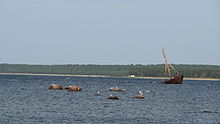Iosif Stalin
|
The ship after it was half sunk and aground
|
||||||||||||
|
||||||||||||
|
||||||||||||
|
||||||||||||
|
||||||||||||
|
||||||||||||
The Iosif Stalin ( Russian Иосиф Сталин ) was a Soviet passenger ship that was renamed the VT-521 after the start of the German-Soviet War and used as a troop transport.
The Iosif Stalin and her sister ship Wjatscheslaw Molotow were built in Amsterdam by Nederlandsche Dok en Scheepsbouw Maatschappij from 1939 . It was handed over to the Soviet Union on May 1, 1940 . Initially used for civilian passenger transport, it was renamed WT-521 after the start of the war .
The ship was used in the evacuation of Tallinn in 1941 and was later used as a troop transport to evacuate the Soviet naval base in Hangö , Finland . The Hangö naval base was established in March 1940 after the Peace of Moscow and was supposed to be evacuated in December 1941 before the approaching German troops. The ship came with 5589 soldiers on board on December 3, 1941 in the Gulf of Finland in the German Corbetha - minefield . The Corbetha barrier was launched on June 22, 1941 by the German miners Cobra , Queen Luise and Kaiser and consisted of 350 unit mines type C (EMC) and 570 explosive buoys . Despite being accompanied by several anti-mine vehicles, the ship hit three or four mines and was also hit by Finnish coastal batteries . The last mine hit or a 305 mm gun hit detonated artillery ammunition on the ship. This explosion killed numerous soldiers. The ship partially sank. It drifted rudderlessly to the coast of Estonia and ran aground. Anti-mine vehicles of the convoy were able to rescue 1740 soldiers. Several anti-mine vehicles were damaged during the rescue operation, one exploded after it hit a mine. The German Navy was able to take over the ship and capture the soldiers who had not yet been recovered.
Almost 3,000 Soviet soldiers were rescued by Soviet minesweepers and later by German outpost vehicles. Around 2,600 soldiers were killed. The ship was not mentioned in official Soviet history, as the captain had ordered the surrender , although weapons and ammunition were still available on the ship for a defense against the Germans.
The wreck is still visible off the coast today.
See also
Web links
- Что произошло с лайнером «Иосиф Сталин»? ( Memento from April 17, 2013 in the web archive archive.today )
- The Soviet Fleet - Iosif Stalin class
- Picture by Adolf Bock 1942
- Sea War December 1941
Individual evidence
- ^ Military Library (Russian), accessed June 4, 2015
- ↑ Mine barriers at the exit of the Finnenbusens (1941)
Coordinates: 59 ° 54 ′ 0 ″ N , 25 ° 9 ′ 0 ″ E

